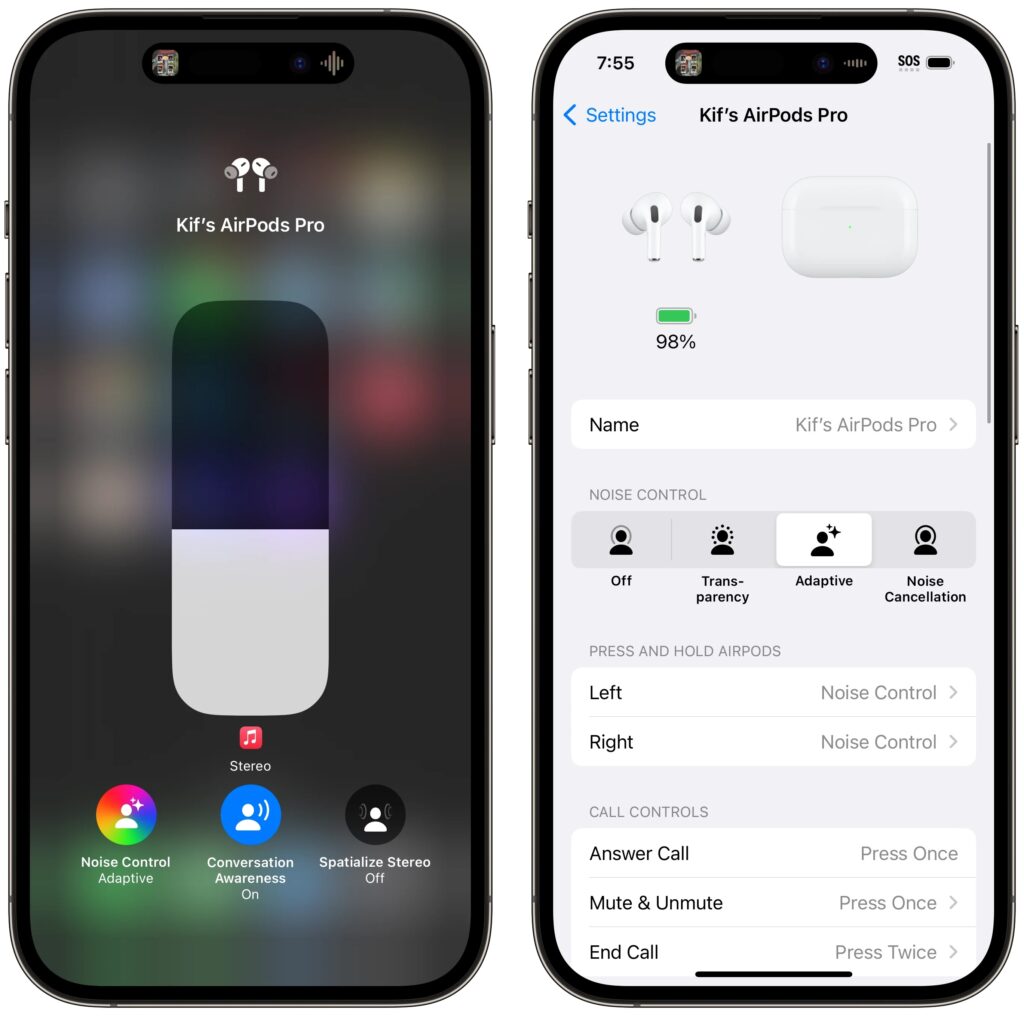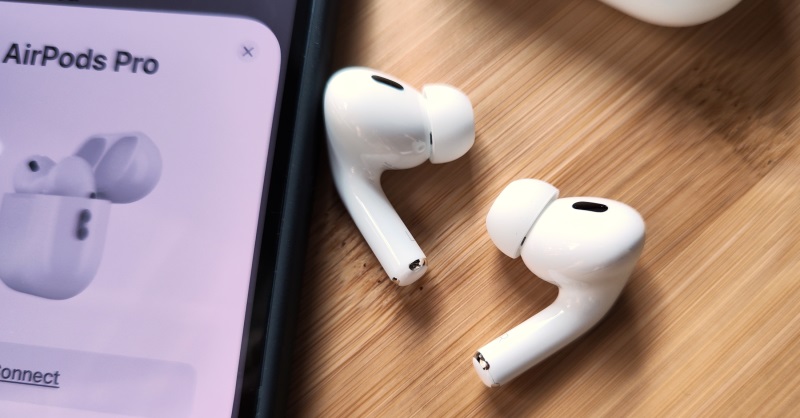This month, Apple is also releasing an updated model of its AirPods Pro along with new iPhones and Apple Watches.
The cumbersomely named 2nd Generation AirPods Pro with USB-C don’t feature any significant hardware upgrades. To be consistent with the rest of its portfolio, Apple switched out the proprietary Lightning port for a USB-C charger.
However, a slew of software upgrades that debut alongside the new AirPods fundamentally alter how noise-cancelling on the wireless earbuds really functions. These upgrades also make it considerably simpler for AirPods Pro owners to leave their earbuds in all day whether traveling or conversing with coworkers.
With the default settings on a review unit of the new $249 AirPods, the device ultimately uses machine learning and artificial intelligence to turn down music when in a conversation or allow necessary nearby sounds into the headphones. Apple has given the new features various names, including “Adaptive Audio,” “Conversation Awareness,” and “Personalized Volume.”
Users may now leave their AirPods in and rely on Apple’s software to intelligently determine what they need to hear instead of pulling out their AirPods or completely turning off noise-canceling whether they’re negotiating a hazardous street or speaking with a coworker.
The changes are generally small yet lovely. They are not a cause to update AirPods if you already have an older pair that is in fine functioning condition, but they are something to consider if you are purchasing new wireless headphones and are aware that you don’t like to take them in and out all the time.
The new AirPods are intriguing from a technology standpoint, though. With the use of artificial intelligence (AI), Apple is leveraging cutting-edge technology and its own custom chips to filter the world of sound through Apple’s hardware and to enhance or mute specific noises to improve your daily experience. The noise-cancelling capabilities of Apple’s headphones go much beyond the basic on/off switches found on rival products.
The idea is similar to the “spatial computing” Apple debuted with the Vision Pro VR headset, which employs machine learning to combine the real world and digital worlds. Apple refers to the AirPods as a “wearable,” and it includes sales of them in the same Apple Watch revenue category. Even though they don’t receive as much attention as the iPhone, the AirPods continue to be one of the company’s most exciting product lines in terms of a glimpse into the future of computing because to their new adaptive features.
How it operated
While the adaptive technology is still not entirely seamless, it is a welcome advance over the AirPods Pro’s previous default noise-cancellation mode, which was a harsher, muffled option. Furthermore, it’s not just available on the newest hardware; users of the “second generation” AirPods Pro, which were released in September, may download upgrades to their iPhone’s operating system to enable them.
In the end, the new Adaptive mode combines the artificial silence of active noise reduction with the frantic city noise. When consumers are walking through cities, Apple positions Adaptive Audio as a safety feature to ensure they don’t miss honks or other noises. It is subdued. It’s clear that you still feel as though you’re in a silent cocoon, but you don’t have the impression that everything is muted around you.
When users switch it on, either through the Settings app when the earphones are plugged in or through a shortcut by long-pressing the volume button on the iPhone in the Control Center, there is a small chime.

Although Adaptive Audio wasn’t flawless in practice, it beat out Apple’s transparency mode, which frequently magnifies unwanted noise (such the AirPods case rattling against the vehicle keys in my pocket), and active noise cancellation, which can be extremely isolating. I would utilize Apple’s Adaptive mode if I had to stroll around cities, which I try to avoid for safety reasons.
However, announcements from Bay Area BART stations that were broadcast over a central speaker were still difficult to hear, especially when I was listening to music. To hear what they were saying, such as which train was entering the station, I still had to turn the headphones off or take them off.
Adaptive Audio didn’t perform as well as active-cancellation mode when going through a dog park that was sound-insulated from a motorway. Later, when someone else in the park was creating a disturbance and arguing, I didn’t hear it since I saw the argument before I heard it in Adaptive mode. Although many people use noise-canceling headphones to block out those kinds of disruptions, urban residents should be aware of them in their area from a safety viewpoint.
Another important application for noise-canceling headphones is in the workplace, where returning employees are increasingly utilizing them to communicate their inability to speak or to replicate the solitude of a home office.
The Conversation Awareness function will really shine in this situation, enabling office workers to have brief chats without removing their AirPods. When the function detects that you are participating in a conversation, it essentially mutes your music or audio. The program does everything for you and even slightly intensifies the dialogue so you don’t have to fiddle with the settings to turn off noise-canceling or the music or take out the earbuds.
It’s wonderful when it functions. With the AirPods in and Conversation Awareness turned on, I had a few discussions with my wife. We conversed as if the $250 technology in my ears weren’t there, and as soon as I resumed my previous activities, the music’s volume returned to normal levels on its own.
However, there is a significant drawback to Conversation Awareness: it doesn’t begin when someone speaks to you; rather, it only begins when you open your mouth and speak. As a result, I frequently found myself missing the first statement made in interactions, such as when a neighbor welcomed me or when I approached my preferred taco truck.
I began to regret not bringing my AirPods to the taco truck. I did feel like I was disrespectful for having my headphones in during the brief chat because I felt like I was missing some of the context. I heard and comprehended the crucial information, including the overall cost, but I didn’t feel as though we were having a real-time conversation as we would have if I had been speaking normally without headphones.
Additionally, when the cashier called out my order for pickup five minutes later, Conversation Awareness did not turn down my music. In the end, I placed the wrong order as well, perhaps because I was preoccupied. However, it’s simple to imagine how users may employ the function to place a cold brew order without halting their music.
There are further minor peculiarities. When I’m by myself, I enjoy singing along to the music. The music is lowered down while Conversation Awareness is activated, so you can only hear your own flat singing. I once chuckled while using my computer, which caused the AirPods algorithm to believe I was speaking. Additionally, I had no idea how much I mutter to myself while I write.
The overall audio level is adjusted by Personalized Volume using machine learning, taking into account your prior preferences (for me, louder than is healthy) and the ambient noise. Once, after I had turned up the level, I only became aware of it.
With all of this in mind, the new AirPods features might not be a compelling incentive to upgrade right now, but they do demonstrate how far Apple’s headphones have come from their humble beginnings as tiny speakers.






